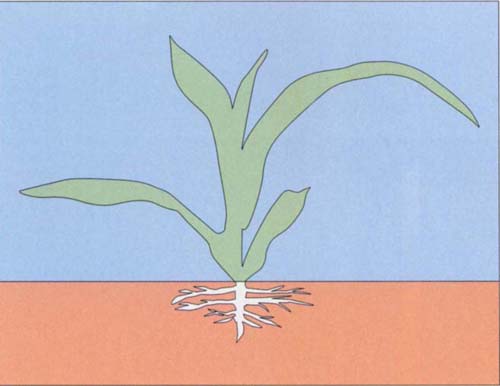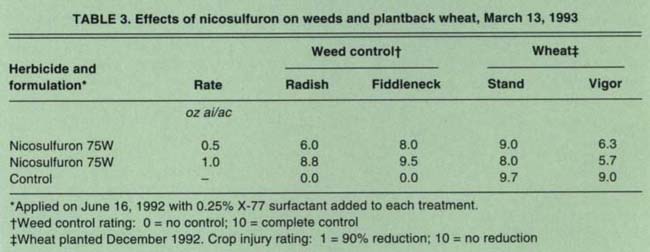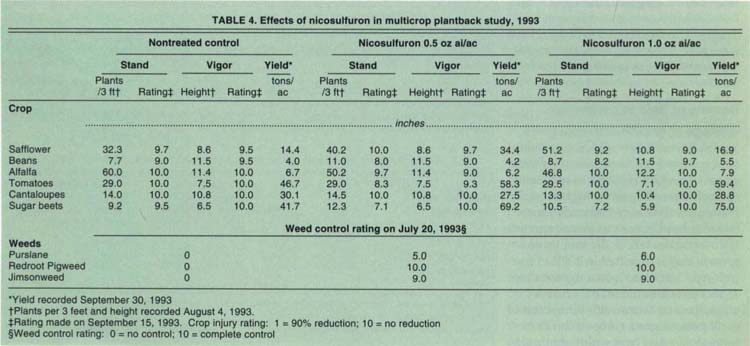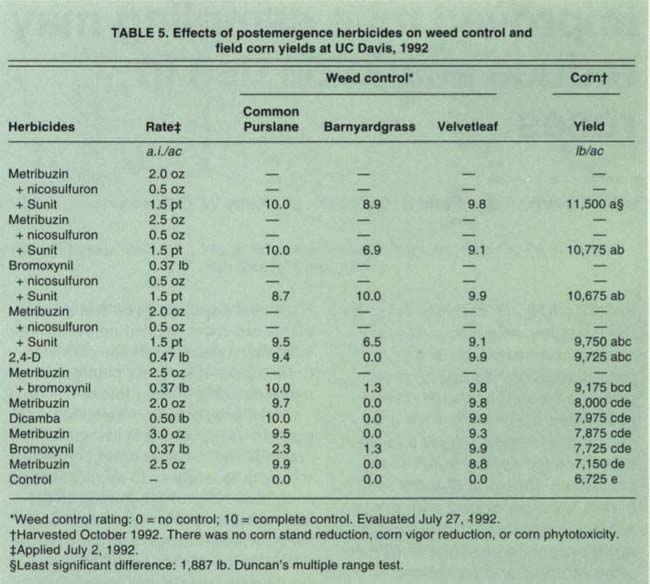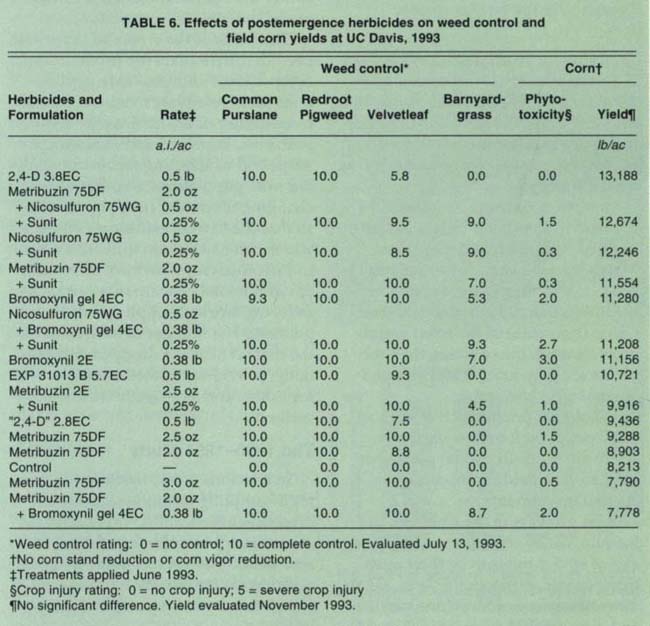All Issues
Postemergence herbicide controls johnsongrass, other weeds in field corn
Publication Information
California Agriculture 49(3):33-37. https://doi.org/10.3733/ca.v049n03p33
Published May 01, 1995
PDF | Citation | Permissions
Abstract
The new postemergence herbicide nicosulfuron (Accent) makes integrated management of johnsongrass, Sorghum halepense (L.), in field corn economically feasible and environmentally sound. In a study of its effect on johnsongrass and field corn in Yolo and Sacramento counties, nicosulfuron provided control of johnsongrass at all growth stages. However, early treatments resulted in the highest corn yields.
Full text
Postemergence application of nicosulfuron at 0.5 oz ai to field corn and johnsongrass at various stages of growth resulted in excellent control of seedling johnsongrass, left, compared with the control, right.
In 1994, 370,000 acres of field corn, with an economic field value of $185 million, were planted statewide; 220,000 acres were harvested for silage and 150,000 for grain. Throughout most of the state, corn growers suffer economic losses because of competition from johnsongrass, Sorghum halepense (L.), which results in grain corn yield reductions and reduced feeding value of corn silage. In the San Joaquin-Sacramento River Delta, control of johnsongrass has been unsuccessful, especially where crop rotation is limited to corn and wheat. Our studies show that control of this species is now economically feasible and environmentally sound using the new postemergence herbicide nicosulfuron (Accent), combined with other agronomically sound management practices.
In 1928, johnsongrass seed arrived in California in shipments of sudangrass seed from Texas and Oklahoma. Eventually it johnsongrass became established throughout the state, except in the Imperial Valley where it was declared a noxious weed and eradicated.
In the Delta, johnsongrass is the most limiting factor in the production of corn grown for grain and silage, with severe competition from both seedling and rhizomatous johnsongrass. It also serves as a host for the debilitating sugarcane mosaic virus, which is often transmitted by aphids from johnsongrass to corn.
The present integrated management system for johnsongrass control includes flooding wheat stubble in late summer; applying preplant incorporated herbicides; making fall and spring applications of glyphosate to control johnsongrass on ditch banks, set aside acres, and fields scheduled for planting cultivation where soil is thrown to the corn row; and crop rotation. Some growers use all or most of these methods, while others practice a more limited management system. Regardless of the methods used, johnsongrass control is marginal at best.
The extensive water network in the Delta facilitates the spread of johnsongrass seeds. Johnsongrass grows on ditch banks and drops seeds into the water so that they disperse to become established on other ditch banks and eventually in new fields. The reservoir of seeds and rhizomes in some fields is so great that even when johnsongrass is controlled on the ditch banks, an extensive population still remains in the fields. Although growers attempt to control the species on the ditch banks with an annual glyphosate application, a new flush of seedlings soon takes over and rhizomes often resprout. Growers are reluctant to use preplant incorporated herbicides because of the high energy requirement of double disking, which also causes loss of soil moisture and loss of soil due to wind erosion.
In Yolo and Sacramento counties, nicosulfuron was found to give outstanding control of seedling and rhizomatous johnsongrass and barnyardgrass with excellent tolerance by corn when applied as a postemergence treatment at 0.5 oz active ingredient (ai) per acre (0.0125 lb ai/ac). Excellent control of broadleaf species was also obtained when nicosulfuron was combined with metribuzin and bromoxynil.
Corn grown for grain
We established three studies to measure the effects of nicosulfuron as a postemergence herbicide for control of johnsongrass and other weed species. A stage-of-growth study was conducted on Tyler Island in the Delta on an Egbert muck soil to determine the effect of nicosulfuron on johnsongrass at 0.5 oz ai per acre when applied at four growth stages 1 week apart. Plots were randomized, complete block, four rows by 20 feet, with four replications. The first treatment was made when the corn was 1 (two-leaf),2,3 and 4 feet (seven-leaf) tall (table 1).
We conducted a second yield plantback study in Natomas on a sandy loam soil to determine the effect of nicosulfuron applied at 0.5 and 1.0 oz ai/ac on the various weed species, corn yield, crop tolerance and following rotational crops. Application was made on June 16, 1992, to Asgrow 125 corn in the five-leaf stage. Plots were randomized, complete block, 12 rows by 50 feet, with three replications. In October 1992 the corn was hand harvested, followed by a minimum till operation. Yolo wheat was planted in December 1992. Stand and vigor ratings were taken on the wheat in March 1993. The field was disked, new beds were formed, and in August 1993, 12.5 months after the nicosulfuron treatments, we planted two rows each of six rotational crops: dry beans, alfalfa, tomatoes, safflower, cantaloupes and sugar beets. One month after planting, we took stand counts and vigor measurements. Plant biomass was measured 85 days after planting.
In 1992 and 1993 we conducted a postemergence study on the Agronomy Farm at UC Davis on a Yolo loam soil. Comparisons were made of nicosulfuron and the broadleaf herbicides metribuzin, bromoxynil, 2,4-D, dicamba and combinations of nicosulfuron and the broadleaf herbicides. Visual ratings of control were made on purslane, barnyardgrass and velvetleaf, and tolerance ratings were made on the stand, vigor and phytotoxicity to the field corn. In October of each year the trials were hand harvested for yield.
In the postemergence experiments, applications were made over the top of the corn and weeds with a CO2 backpack sprayer in 30 gallons of water per acre, with four replications in a randomized complete block design. Plots were four rows by 20 feet. The center two rows were hand harvested. The plantback and UC Davis studies were furrow irrigated; the Tyler Island Delta study was irrigated by spud ditches. The surfactants X-77 and Sunit were added to the nicosulfuron treatments at 0.25%, as noted in tables 1 and 2.
Results of field experiments
Stage of growth
Postemergence application at 0.5 oz ai nicosulfuron to field corn and johnsongrass at various stages of growth resulted in excellent control of seedling johnsongrass in all treatments (late May and early June, table 1). Applications to johnsongrass 10 to 20 inches tall, at the first three growth stages, resulted in 100% control. Application to johnsongrass 43 to 48 inches tall, at the fourth growth stage, gave 91% control. Elimination of early johnsongrass competition in four- to five-leaf corn resulted in a significantly increased yield of 10,358 pounds per acre (lb/ac), 2,358 lb/ac more than the control (fig. 1). When nicosulfuron was applied to corn in the five- and six-leaf stage and johnsongrass 20 to 48 inches in height, yields were 8,400 and 8,300 lb/ac, respectively (fig. 2). These latter treatments were comparable to the control yield of 8,000 lb/ac.
Rotational nicosulfuron plantback study
In June 1992, nicosulfuron was applied postemergence at 0.5 and 1.0 oz ai/ac to field corn in the five-leaf stage. The weed spectrum consisted of seedling johnsongrass, purslane, redroot pigweed, jimsonweed, mustard and malva. Weed control was excellent at both rates for all species (table 2). There was no corn stand or vigor reduction and no phytotoxicity with either nicosulfuron rate. However, the corn yield increased significantly, from 5,000 lb/ac for the control (cultivated) to 6,600 lb/ac at 1.0 oz ai/ac and to 7,700 lb/ac at 0.5 oz ai/ac. The following spring and summer, in March and August of 1993, wild radish, coast fiddleneck, common purslane, redroot pigweed and jimsonweed were still being controlled from the previous year's application of nicosulfuron (table 3).
TABLE 2. 1992 results of Natomas nicosulfuron postemergence field corn plantback study—initial application
Plantback rotational crops
Stand and vigor of Yolo wheat planted in December 1992 were reduced at both application rates. The 0.5 oz ai/ac rate slightly reduced the stand and significantly reduced the vigor by 27%, while the 1.0 oz ai/ac rate reduced the stand by 17% and the vigor by 32% (table 3).
In the multicrop plantback study planted on July 5, 1993, the early vigor of beans was reduced at the 1.0 oz ai/ac rate of nicosulfuron (table 4). Tomato and cantaloupe early vigor was reduced at the 0.5 and 1.0 oz ai/ac rate. On September 15 the vigor of all six crops was equal to the control and only the tomato stand was reduced. However, this finding was not reflected in the vegetative yield. The crop vegetative weights for the 1.0 oz ai/ac treatment were higher than for the control (table 4).
UC Davis field studies
In the 1992 study (table 5), excellent control (89 to 100%) was obtained on common purslane, barnyardgrass and velvetleaf using the combinations of 2.0 oz ai metribuzin + 0.5 oz ai nicosulfuron + 0.25% Sunit; and 0.37 lb. ai bromoxynil + 0.5 oz ai nicosulfuron + 0.25% Sunit. These treatments resulted in the highest corn yields: 11,500 pounds per acre for the metribuzin + nicosulfuron and 10,675 pounds per acre for the bromoxynil + nicosulfuron combination. Dicamba, 2,4-D and metribuzin gave excellent control of velvetleaf and common purslane. Yields were significantly reduced from lack of barnyardgrass grass control with dicamba, 2,4-D, metribuzin and bromoxynil.
In the 1993 study (table 6), the best control of barnyardgrass, velvetleaf and common purslane was obtained with nicosulfuron + Sunit; nicosulfuron + bromoxynil + Sunit; and nicosulfuron + metribuzin + Sunit. These treatments also resulted in the highest yields. However, there was no significant difference between yields. As in the 1992 study, wherever there was significant barnyardgrass competition, yields were lower than where control was 89% or better.
Conclusions
Competition from johnsongrass and barnyardgrass causes significant economic yield losses in field corn. Elimination of johnsongrass at the early growth stages of the corn is crucial to increasing the yield by 1 ton per acre (fig. 2). However, excellent control of seedling and rhizome johnsongrass along with excellent corn tolerance can be obtained through an integrated weed management system that includes rotation, summer flooding of wheat stubble, glyphosate for johnsongrass control along ditch banks and set aside areas, cultivation, preplant incorporated herbicides, and the new postemergence herbicide nicosulfuron (figs. 3 and 4). Excellent broad-spectrum weed control can be obtained by combining nicosulfuron with the broadleaf herbicides metribuzin, bromoxynil, 2,4-D and dicamba.
The effect of controlling johnsongrass amounts to a yield increase of 1 ton per acre. Economically, when corn sells for $100 per ton, this means an extra $10 million for every 100,000 acres treated.




